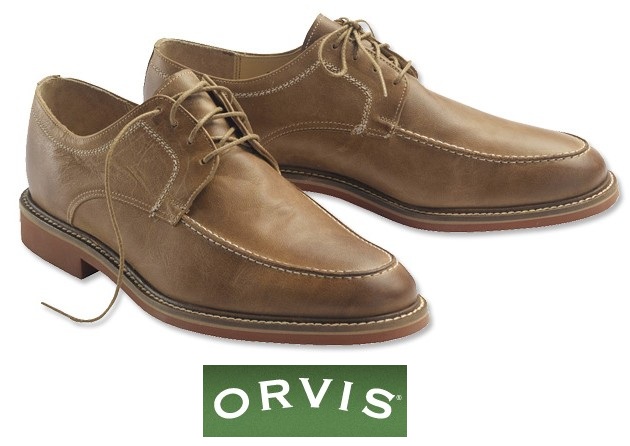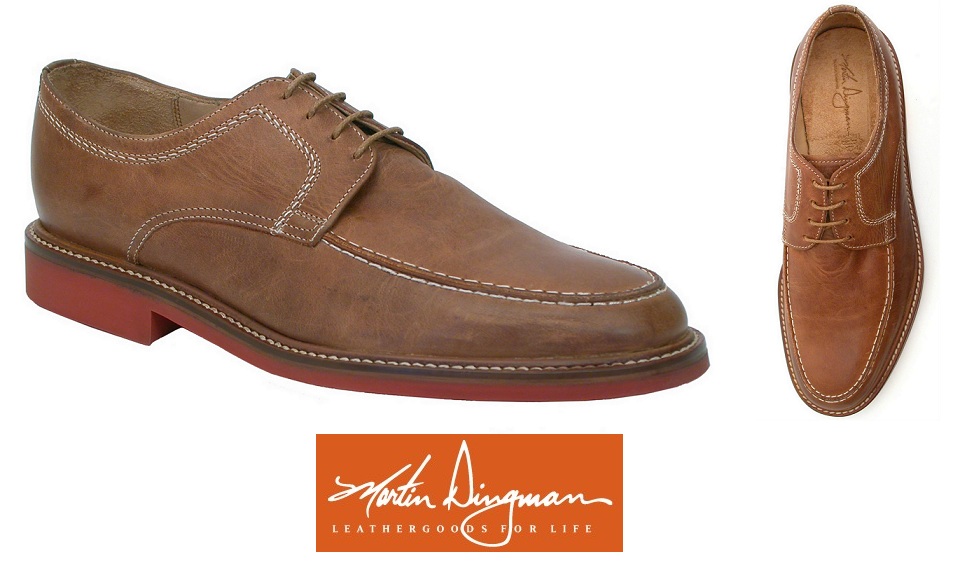There was an interesting brand development that happened a few months ago between Land’s End and Kiel James Patrick in regards to a belt. The story seemed to have a happy ending, with Lands’ End discontinuing the KJP knockoff. Big kudos to Ivy Style for covering the story from a fact-based and objective perspective.
Let’s talk about another situation that may not pass the ‘red-faced’ test. Our great friends over at Martin Dingman confirmed that Orvis is selling a shoe that is eerily familiar to a Martin Dingman model.
In this corner, Orvis’ ‘Saddle-Leather Oxfords’:

The description (direct from the Orvis website): Handsewn full-grain leather construction lends our Oxfords classic looks and unbeatable comfort; the soft leather lining ensures an easy fit that conforms perfectly to your foot. Brick-red latex-rubber outsole. Stitched-welt construction provides durability and flexibility. Leather Oxford shoes in copper. Genuine leather upper. Imported.
And in this corner: Martin Dingman’s ‘Ernest’:

The Ernest was available in the Martin Dingman Spring ’11 catalog (no longer available on the website).
As was mentioned in the KJP vs LE situation, fashion designs cannot be copyrighted, and being knocked off by a corporation is one of the risks of working in the clothing and accessories business.
***I have sent this situation to Orvis for comment, and will publish their response***
So what say you, dear readers? As Christian asked ‘is this an everyday example of the free-market economy at work, or a low blow’? Does this pass the red faced test?

It’s a bit tacky, but obviously not illegal. I do find it distasteful, especially from an otherwise solid company like Orvis. But how does MD know that the Orvis shoes won’t be solid for the long haul? Orvis’ standards are usually pretty high from a quality control standpoint. The issue with the KJP/LE kerfuffle was made worse by KJP’s carrying on about how he was resurrecting American manufacturing by making belts and bracelets.
This is a free market at work. Sure, it’s unfortunate that Martin Dingman’s design was knocked off, however some people are willing to pay less for something that looks the same even if it is not the same quality, whereas others want the look and quality to match and are willing to pay the price for it. Additionally, I wonder why Martin Dingman is so worked up about the issue at hand when this product is no longer available on their website and was part of their Spring 2011 collection.
This is an interesting topic and a good thread – when is a copy just fashion trend, versus a rip off of design.
I do have to point out a couple of issue with the Dingmans claims here though. Isn’t the Dingman website full of shoes that very closely resemble other designers? For example, they sell a lot of Gucci-like horsebit loafers (as do many, many others). Also, their claim that nobody uses saddle leather is not extremely convincing. Allen Edmonds has a whole line of saddle leather shoes. I recognize that their issue is with the striking similarity of the fit, finish, etc. In this case, I do not see the shoes as so shockingly original in the first place that you would expect them to be “proprietary” to Dingman.
I wonder if they have confirmed that the maker of Orvis’ shoes is not the same as the Dingman maker? My guess is that the fault may be at the factory level (I know Dingman makes their own belts, but I assume they do not make their own shoes??).
I have the same response to this as I did KJP’s whining: Them’s the breaks, kid.
I agree the Lands End situation is shockingly blatent, but the shoe example seems like an overreaction to me. Plenty of other sellers use the term “saddle leather.” Regardless, doesn’t this happen ALL the time? Gant puts a “pin up girl” under the cuff of its madras shirts about a decade after Paul Smith. I’ve seen a bunch of suede/leather contrast wing-tips offered this fall that look almost identical to the Barker Black ones that got all that press a couple years back. Vineyard Vines, Sourthern Proper…etc. blatently riff on the patterned silk ties offered by Hermes and Ferragamo…etc. Haha, actually, just about everythign VV peddles seems derivative to me.
Blatant rip-off? maybe. Are both of these shoe designs similar to a hundred other designers? absolutely. Unfortunately, for many designers, that is the downside of the fashion industry. Without a doubt, in my opinion, this is worse in men’s footwear. You go into any women’s shoe department or boutique and you can see where designers could get their feathers ruffled with being knocked off, it is true art sometimes. Go into any men’s shoe department and 90% of the options are the same bland loafers, that put side by side, most people would never know the difference of designers. Don’t get me wrong, these are really nice, well crafted shoes we are talking about here, but if a men’s footwear designer wants to get bent out of shape about being knocked off, then design some detail that is truly unique to that designer so that you KNOW when you are being knocked off.
I was firmly behind KJP and the IvyStyle article. Regardless of my opinion on KJP’s product line, ignoring his ties, he’s putting out unique products that occupy a distinct niche in a small(er) market. Some might say my distinction is a bit arbitrary, but I’m hammering this out over a coffee break so bear with me.
When applying the principle to shoes, I don’t know that a similar situation warrants the same attention or reaction. There are several bases upon which this theory rests including the size of the market and the number of alternatives that are more or less substitutes. Think about the non-athletic shoe market and whether or not attention should be given to imitation? At what level or juxtaposition of quality does this point need to be made? High end v. high end? Middle v. Middle? High v. Middle? High v. low? Etc. Yes, similar shoe styles can be called “knock offs”, but where does one draw the line, and more importantly, is there an actual line to be drawn? If that line exists, is it even worth it?
Some current examples:
Allen Edmonds just brought back an Alden LHS replica- the “Patriot.” It’s made in USA, offered in Horween shell, and features the LHS’ characteristic mock-moc toe stitching. Sure, AE used to have a similar model, the Cole, but that too bore a strong resemblance to the Alden LHS. I haven’t encountered anyone complaining about either model’s similarity to the LHS. In the same class, what about the Ralph Lauren Darlton penny, via Crockett & Jones? The Brethren’s exclusive Unlined Shell penny (via Alden) v. the C&J Harvard? Should any of these companies grumble about what’s going on? I recognize the distinction here, as all of the above examples are equals rather than “knock-offs,” but it’s something to consider if one is looking to grumble about this.
A more comparable example- consider the classic and arguably most authentic, but now cheap and shoddily-made, Weejun? Consider the situation presented with the various handmade, upscale variants from Rancourt, Quoddy, Eastland, and whoever else offers a $200+ hand sewn, true moc construction penny? Now we’re looking at a cheap original v.”luxury” interpretations, but don’t tell me Bass isn’t losing market share because people are willing to spend double on a pair of shoes that will outlast 3-4 pairs of Weejuns. Should Bass grumble?
A similar situation exists with Top-Sider variants? “Equals” in the case of Sperry v. Sebago. Outclassed by Quoddy, Yuketen, Russell, Eastland, Oak Street Bootmakers, etc. “Knocked off” by West Marine, Urban Outfitters, and whoever else does an A/O or Billfish imitation. There are offerings in the boat shoe market at Sperry’s level, above, and below it. Should Sperry grumble?
Is the offense and “harm” mitigated by the fact that many of the aforementioned companies are offering higher-quality, or arguably fungible versions of the original instead of the “knock off” situation with Martin Dingman and Orvis? I think so, partially at least, but this is how the free market works. Create a superior product and hope that consumers recognize the value you’ve created, otherwise prepare to deal with competitors at, above, and below the quality level that you’re producing.
I believe in both individual and corporate intellectual property rights, both in law and fundamental principle, but in the case of footwear, I simply don’t believe that most “originals” demonstrate or possess such distinctive character to warrant any claims, formal or not, on the basis of propriety. As for those that do, I think that IP law would have incorporated protection of “fashion” design if there was a legitimate policy interest at hand. Let the free market do its job; if I were Martin Dingman, I’d want to demonstrate having more confidence in my product and/or find some way to create something that was immediately recognizable as a Martin Dingman product.
If anyone’s interested, there’s actually an argument, made my legal scholars, that copying is actually what drives the creative cycle in fashion. Money quote:
—Without copyright restrictions, designers are free to rework a design and jump on board what they hope will be a money-making style. The result is the industry’s most sacred concept: the trend. Copying creates trends, and trends are what sell fashion. Every season we see designers “take inspiration” from others. Trends catch on, become overexposed and die. Then new designs take their place.
This cycle is familiar. But what is rarely recognized is that the cycle is accelerated by the freedom to copy. fashion industry. I—
New York Times op-ed here: http://www.nytimes.com/2010/08/13/opinion/13raustiala.html?_r=0
If anyone’s interested, there’s actually an argument, made my legal scholars, that copying is actually what drives the creative cycle in fashion. Money quote:
—Without copyright restrictions, designers are free to rework a design and jump on board what they hope will be a money-making style. The result is the industry’s most sacred concept: the trend. Copying creates trends, and trends are what sell fashion. Every season we see designers “take inspiration” from others. Trends catch on, become overexposed and die. Then new designs take their place.
This cycle is familiar. But what is rarely recognized is that the cycle is accelerated by the freedom to copy. fashion industry. I—
I suppose it’s a ripoff in so much as every shoe company that puts out a similar colored saddle oxford or a nubuck, red sole oxford is ripping off another design. Sure it looks like they might have been knocking it off some, the biggest indictment being the stitching, but what can they do about it? Not much in my opinion.
Orvis also knocked off Viyella shirts. Same patterns they had last year. Same combination of fabric.
http://www.orvis.com/store/product.aspx?pf_id=6K99&dir_id=885&group_id=2685&cat_id=15588&subcat_id=15560
I don’t find KJP’s designs particularly original so I find it rather hollow when he claims to be “ripped off” by Lands End. This is a similar situation. This shoe is a variation on a red soled dirty buck. There are literally 100s of variations on this out there.
It’s pure laziness on Orvis’s part. The idea of an Oxford shoe is owned by no one, so if Orvis’s designers liked the Dingman design, why not emulate it rather than copy it down to the description? Too bad, I like some Orvis products but this is insulting.